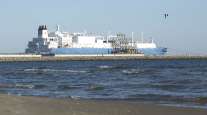Why Shippers Are Turning to LNG-Powered Vessels

When Tote Inc., a shipper that operates between the United States and the Caribbean, launched its latest containership last month, the 760-foot craft carried a certain distinction: It’s only the second of the massive vessels worldwide fueled by liquefied natural gas.
The first was launched four months earlier by the same company.
Tote is among a growing number of ship owners turning to natural gas at a time of record output, stringent emission rules and churning oil prices. About 70 vessels of all sizes worldwide of are powered by LNG, up from 42 in just two years, according to DNV GL, which certifies ships for safety. By 2020, the number may pass 1,000.
“More companies see natural gas as a viable alternative-fuel source, given the abundance of supply and the relatively stable prices,” Peter Keller, executive vice president of Princeton, New Jersey-based Tote, said in a telephone interview. At the same time, “the environmental consciousness of the maritime industry has increased,” he said.
LNG prices are expected to trade in a relatively narrow range as exports from the United States and Australia rise and global demand, pressured by China’s slowing economy, remains sluggish, according to an Aug. 21 report by Bank of America Corp.
Meanwhile, fluctuating fuel oil prices are viewed as a challenge by many in the industry. West Texas Intermediate crude oil for next-month delivery settled at $44.91 a barrel Sept. 24 on the New York Mercantile Exchange after climbing above $60 in May and June.
“Oil has tumbled to 40 bucks and may be back up to 85 or 90 a year from now. Who knows?” Keller said. “You can’t run a business with a long-term horizon with that kind of volatility.”
Natural gas output in the United States., the world’s largest producer, rose to a record 2.455 trillion cubic feet in December, according to the Energy Information Administration. Marketed production will expand 5.7% to 78.95 billion cubic feet a day in 2015, the government estimates.
Cheniere Energy Inc.’s Sabine Pass terminal in Louisiana is scheduled to export the first cargo of LNG from the lower 48 states in the fourth quarter. At the same time, Australia is adding to the glut with two liquefaction projects entering service later this year.
“Spare U.S. liquefaction capacity could aggravate the ongoing spot LNG market glut,” Max Denery, a Bank of America analyst, wrote in the report. “Longer term, the critical question for LNG global prices is whether there will be enough demand to meet incremental supply from Australia and the U.S.”
As the drop in oil prices makes gas less competitive, orders for new LNG ships have tapered off somewhat, said Anders Mikkelsen, a business development leader for maritime advisory at DNV GL in Oslo, Norway. However, he believes the slowdown will be short-lived.
“No one expects oil prices to remain low,” Mikkelsen said by telephone. “They’re likely to increase over the next two to five years, so shipowners are still looking at LNG.”
While pricing is one reason behind the switch, an increasing global emphasis on curbing climate change is another. LNG reduces carbon dioxide pollution by at least 20% and eliminates sulfur dioxide emissions compared with standard bunker fuel, according to DNV.
More centers for loading LNG onto ships as fuel will be developed in the next four to five years, according to Grahaeme Henderson, vice president for shipping and maritime at Shell International Trading & Shipping in London.
“We’re starting in Rotterdam; we anticipate that further hubs in Singapore and the U.S. will follow thereafter in a global network,” Henderson said in a telephone interview, referring to industry trends and not just Shell’s own operations. The U.S. doesn’t yet have an LNG fueling hub, according to ship broker Poten & Partners Inc.
One bar to the growing interest in LNG-powered ships is the cost to produce them. They are 10 to 25% more expensive to build than comparative vessels running on fuel oil, and it will take owners of gas-fueled ships five to eight years to recover those costs, Mikkelsen said. The insulated storage tanks needed for LNG contribute to the higher price tag.
Tote invested about $350 million in the two LNG-powered containerships, including about $40 million for the LNG tanks and related systems, Keller said. An AGL Resources Inc. unit and WesPac Midstream are building a liquefaction plant in Jacksonville, Florida, that’s scheduled to begin providing fuel for Tote ships in 2016.
Fuel prices tied to Louisiana’s Henry Hub, the benchmark for U.S. gas, may soften the blow. While LNG contracts are historically linked to crude, adding U.S. supply to the market is creating more choice for shipowners, said Jason Feer, head of business intelligence at Poten & Partners in Houston.
“We’re seeing greater diversity in LNG pricing mechanisms,” Feer said by telephone. “People want to see some diversity in shipping fuel and in the short- to mid-term, there’s likely to be quite a bit of LNG available at competitive prices.”




